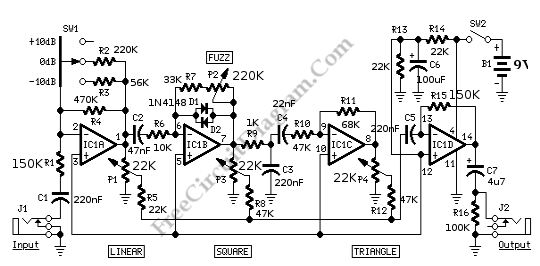Fuzz Distortion with Wave Shaper

Based on the squaring property of two back-to-back diodes connected across output and inverting input of the op-amp, IC1B forms a rather straightforward fuzz circuit. The squared output signal coming from IC1B is converted into a triangle-shaped waveform by IC1C and related components. IC1D is wired as a virtual-earth mixer, summing the linear, squared and triangle-shaped signals coming from IC1A, IC1B and IC1C respectively.
IC1A is the linear input amplifier. We can vary the input sensitivity of the circuit from -10dB to +10dB in three fixed steps by means of SW1, in order to cope with almost any pick-up type and model.
We can done a very accurate mixing of these three different signals by means of P1, P3 and P4. The result will be an almost endless choice of different fuzz-effects. [Source: redcircuits.com]